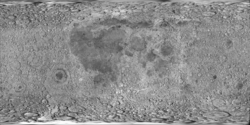Cratere Glaisher
Glaisher è un cratere lunare di 15,92 km situato nella parte nord-orientale della faccia visibile della Luna, nella regione sul bordo sudoccidentale del Mare Crisium, a sudovest del cratere Yerkes e a ovest-nordovest della coppia di crateri Greaves-Lick. È circondato da un anello di crateri minori di varie dimensioni.
| Cratere Glaisher | |
|---|---|
| Tipo | Crater |
| Satellite naturale | Luna |
 | |
| Dati topografici | |
| Coordinate | 13°11′24″N 49°20′24″E |
| Maglia | LQ-13 (in scala 1:2.500.000) LAC-61 Taruntius (in scala 1:1.000.000) |
| Diametro | 15,9 km |
| Profondità | 2,0 km |
| Localizzazione | |
Glaisher è una formazione circolare, con un fondo a forma di conca e livellato nella zona centrale. Il bordo non è stato eroso in modo significativo e adiacente al lato meridionale è presente la coppia di crateri 'Glaisher E' e 'Glaisher G'.
Il cratere è dedicato al meteorologo britannico James Glaisher.
Crateri correlati
modificaAlcuni crateri minori situati in prossimità di Glaisher sono convenzionalmente identificati, sulle mappe lunari, attraverso una lettera associata al nome.
| Glaisher | Coordinate | Diametro (in km) |
|---|---|---|
| A[1] | 12°50′24″N 50°43′48″E | 19,16 |
| B[2] | 12°28′48″N 50°09′00″E | 23,05 |
| E[3] | 12°37′48″N 49°11′24″E | 20,81 |
| F[4] | 13°38′24″N 49°55′12″E | 7,33 |
| G[5] | 12°22′12″N 49°29′24″E | 18,89 |
| H[6] | 13°44′24″N 49°27′00″E | 4,82 |
| L[7] | 13°24′36″N 48°46′12″E | 6,99 |
| M[8] | 13°07′12″N 48°33′36″E | 5,84 |
| N[9] | 13°05′24″N 47°34′48″E | 6,87 |
| V[10] | 11°N 50°E | 12,99 |
| W[11] | 12°33′00″N 47°38′24″E | 48,01 |
Note
modifica- ^ (EN) Glaisher A, su Gazetteer of Planetary Nomenclature, United States Geological Survey. URL consultato il 14 aprile 2021.
- ^ (EN) Glaisher B, su Gazetteer of Planetary Nomenclature, United States Geological Survey. URL consultato il 14 aprile 2021.
- ^ (EN) Glaisher E, su Gazetteer of Planetary Nomenclature, United States Geological Survey. URL consultato il 14 aprile 2021.
- ^ (EN) Glaisher F, su Gazetteer of Planetary Nomenclature, United States Geological Survey. URL consultato il 14 aprile 2021.
- ^ (EN) Glaisher G, su Gazetteer of Planetary Nomenclature, United States Geological Survey. URL consultato il 14 aprile 2021.
- ^ (EN) Glaisher H, su Gazetteer of Planetary Nomenclature, United States Geological Survey. URL consultato il 14 aprile 2021.
- ^ (EN) Glaisher L, su Gazetteer of Planetary Nomenclature, United States Geological Survey. URL consultato il 14 aprile 2021.
- ^ (EN) Glaisher M, su Gazetteer of Planetary Nomenclature, United States Geological Survey. URL consultato il 14 aprile 2021.
- ^ (EN) Glaisher N, su Gazetteer of Planetary Nomenclature, United States Geological Survey. URL consultato il 14 aprile 2021.
- ^ (EN) Glaisher V, su Gazetteer of Planetary Nomenclature, United States Geological Survey. URL consultato il 14 aprile 2021.
- ^ (EN) Glaisher W, su Gazetteer of Planetary Nomenclature, United States Geological Survey. URL consultato il 14 aprile 2021.
Altri progetti
modifica- Wikimedia Commons contiene immagini o altri file sul Glaisher
Collegamenti esterni
modifica- (EN) Cratere Glaisher, su Gazetteer of Planetary Nomenclature, United States Geological Survey.
- (EN) Immagini del Cratere Glaisher, in Atlante fotografico orbitale della Luna, Lunar and Planetary Institute.
